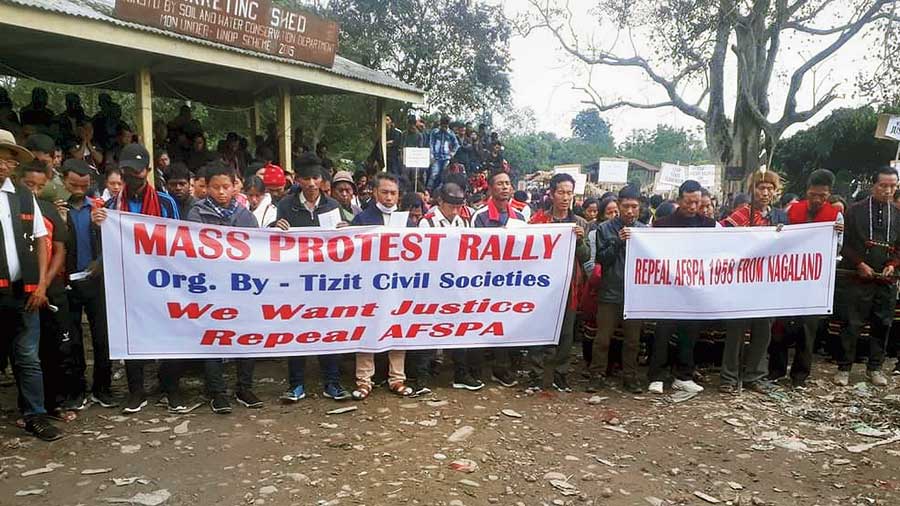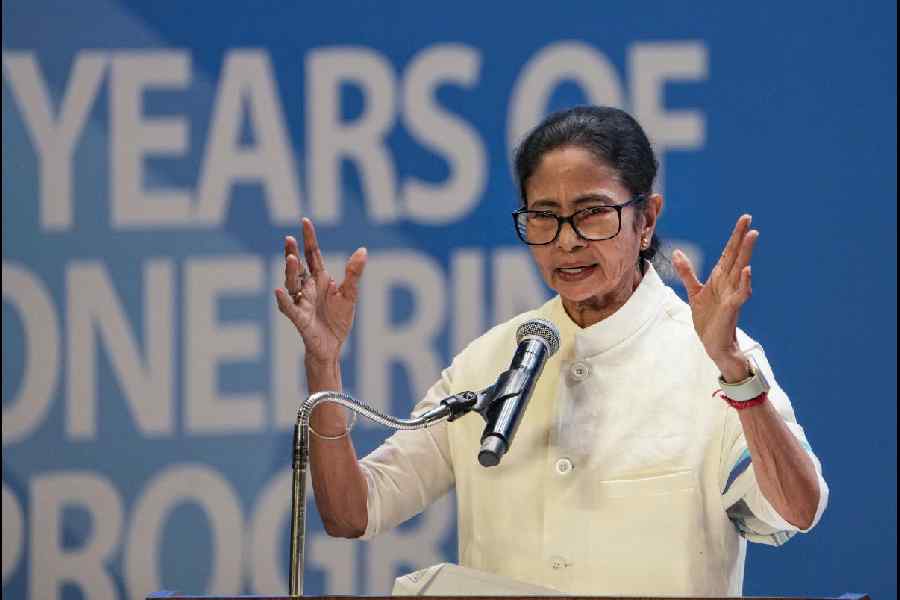Two incidents in the last fortnight demonstrate the paradox of the Indian army. The death of the chief of defence staff, Bipin Rawat, together with several members of the armed forces led to widespread mourning in the national mainstream. Far removed from the mainstream, in Mon district of Nagaland, families of six coal miners grieved the loss of their loved ones. They were wantonly killed by the 21 Para Special Forces unit of the Indian army who “blankly opened fire” at these unarmed men. Destiny has determined that these two incidents, seemingly disconnected, will remain intertwined for posterity. And in this chance intertwining lies the fate of the Armed Forces (Special Powers) Act, calls for whose repeal have resurfaced powerfully.
Any untimely death understandably leads to an outpouring of grief suffused with a palpable sense of injustice. It was no different with CDS Rawat, Brigadier Lidder and their fellow officers. For their families and friends, their grief can scarcely be imagined. But this grief was more than just a sense of loss for a loved one or the shock of an accident that should not have happened. Those who died were soldiers — the individual identities of the officers themselves were secondary to their predominant identity of serving in the Indian armed forces. “We must give him a smiling send-off, I’m a soldier’s wife,” said Mrs Geetika Lidder, her fortitude in the face of tragedy immediately elevating her husband’s death from a family tragedy to a cause for national mourning.
It served as yet another reminder of the sheer respect that the armed forces command in the national consciousness. Armies in most countries are understandably considered epitomes of valour. In India, such valour appears to colour almost everything the armed forces do. Often, this translates into a belief that the army is the panacea for all ills — from quelling internal disturbances to mounting rescue missions from landslides. At other times, that the army can do no wrong — ‘cantonments are so clean’ is an oft-heard refrain. Even doctors, brave in their own right in treating Covid patients round the clock, only have their bravery certified when they are declared to be ‘Covid warriors’.
It is precisely this unquestioned respect for the army that underpinned the decision of the Jawaharlal Nehru government to pass four ordinances in 1947 to bring in the army to restore peace after Partition. That was the genesis of the AFSPA in independent India. The need for such a law was a natural consequence of the recognition that the armed forces were necessary to aid the local police in restoring public order. Police officers are given the power under regular criminal law to use force and are protected against arrest for its possible misuse. If the army was being brought in when the police was inadequate, it was hardly surprising that similar protections were felt necessary.
But AFSPA (especially its later avatars) went well beyond the immunities the ordinary police enjoyed. First, the Central government could declare any area as a disturbed area indefinitely, allowing the army to enter. Second, any army officer could arrest a person without a warrant, on mere suspicion. He could also shoot to kill if he felt necessary. Even if a mission went wrong, he could not be prosecuted unless the government itself sanctioned it. Equally, AFSPA was more than a sum of its parts. The immunity granted to the army to shoot to kill meant that it represented a ‘culture of impunity’, the army itself appearing like a colonial force that cared little about the consequences of its actions in India’s geographical extremities.
Despite these sweeping powers, legal strategies to strike down AFSPA as unconstitutional have not worked. In the Naga People’s Movement judgment, the Supreme Court upheld the constitutionality of the entire Act and said that the “dos and don’ts” followed by the armed forces are sufficient safeguards against misuse. Courts often look for such procedural fixes when faced with fundamental first order questions of balancing the right to life against the requirements of national security. Unable to assess the latter confidently, the limited legal imagination satisfies itself with a procedure that appears to provide respite from wanton lawlessness. In the process, they almost entirely lose sight of the principle that even a junior officer in the army has the license to kill.
The alternative strategy to wait for the ground situation to improve before AFSPA is repealed mischaracterizes the issue as a military one. It results in a convenient counter-factual that can never be tested. How can we know that it’s not needed if the peace that ensues flows from the barrel of a gun? To know whether it is needed or not first requires AFSPA to be suspended, not the other way around.
The destiny of AFSPA ultimately lies in the continued centrality of the army in the public imagination. As long as it appears like a force that can do no wrong, it will remain entrenched in the so-called disturbed areas in the country. Consequently, so will AFSPA.
In this context, when the army has admittedly blundered in Nagaland, a politically astute campaign should focus on amending key provisions of AFSPA. Parliament should be prevailed upon to omit two of its most offensive provisions — allowing army personnel to shoot to kill and making it onerous to punish them in case they have killed someone. This will ensure that the immunities under AFSPA are incrementally equalized with those of the police under criminal law.
Ultimately, the life and liberties of a person in the Northeast cannot be valued differently from another elsewhere in the country. This is the inequity that AFSPA perpetuates with limited evidence of its necessity in maintaining public order. If this is continued, mourning the death of armed forces officers like those on the ill-fated helicopter in Coonoor will be tempered by the undignified deaths of unnamed citizens perpetrated by their colleagues in remote parts of the country. The citizens of the Northeast as well as the armed forces themselves deserve better from Parliament.
Arghya Sengupta is Research Director, Vidhi Centre for Legal Policy. Views are personal










